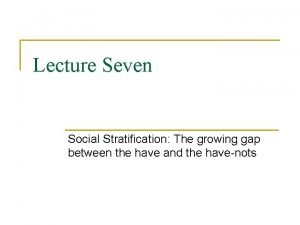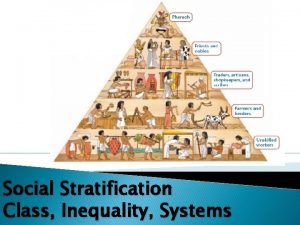NANTAI NVERSTES SOCIOLOGY II SOW 106 SOCIAL STRATIFICATION






![REFERENCES • Giddens, A. (1993). Sociology. Cambridge [England]: Polity Press. NİŞANTAŞI ÜNİVERSİTESİ © REFERENCES • Giddens, A. (1993). Sociology. Cambridge [England]: Polity Press. NİŞANTAŞI ÜNİVERSİTESİ ©](https://slidetodoc.com/presentation_image_h/2320dfa197547e9bf6067b532f2c97e1/image-7.jpg)
- Slides: 7

NİŞANTAŞI ÜNİVERSİTESİ SOCIOLOGY II (SOW 106) SOCIAL STRATIFICATION AND SOCIAL CLASS İktisadi, İdari ve Sosyal Bilimler Fakültesi iisbf. nisantasi. edu. tr NİŞANTAŞI ÜNİVERS İTESİ ©

Social stratification refers to the division of society into layers or strata. When we talk of social stratification, we draw attention to the unequal positions occupied by individuals in society. The concept of social stratification is used to define inequalities that exist between individuals and groups. Stratification is often considered in terms of assets or property, but it can also occur because of other attributes, such as gender, age, religious affiliation or ethnicity. SOCIAL STRATIFICATION NİŞANTAŞI ÜNİVERSİTESİ ©

SOCIALLY STRATIFIED SYSTEMS The rankings apply to social categories of people who share a common characteristic without necessarily interacting or identifying with one another. People's life experiences and opportunities depend heavily on how their social category is ranked. The ranks of different social categories tend to change very slowly over time. NİŞANTAŞI ÜNİVERSİTESİ ©

MARX’S THEORY OF CLASS CONFLICT & WEBER: CLASS, STATUS AND PARTY • The most prominent and influential theories of stratification are those developed by Marx and Weber. • Marx placed primary emphasis on class, which he saw as an objectively given characteristic of the economic structure of society. He saw a fundamental split between the owners of capital and the workers who do not own capital. • Weber accepted a similar view, but distinguished two other aspects of stratification - status and party. Status refers to the esteem or 'social honor' given to individuals or groups; party refers to the active mobilizing of groups to secure definite ends. NİŞANTAŞI ÜNİVERSİTESİ ©

ERIK OLIN WRIGHT’S CLASS MAP Bourgeoisie Small Employers Managers Proletariat Semi Autonomous Workers NİŞANTAŞI ÜNİVERSİTESİ © Petty Bourgeoisie

SOCIAL MOBILITY Intragenerational Mobility Intergenerational Mobility Horizontal Mobility Vertical Mobility Occupational Mobility NİŞANTAŞI ÜNİVERSİTESİ ©
![REFERENCES Giddens A 1993 Sociology Cambridge England Polity Press NİŞANTAŞI ÜNİVERSİTESİ REFERENCES • Giddens, A. (1993). Sociology. Cambridge [England]: Polity Press. NİŞANTAŞI ÜNİVERSİTESİ ©](https://slidetodoc.com/presentation_image_h/2320dfa197547e9bf6067b532f2c97e1/image-7.jpg)
REFERENCES • Giddens, A. (1993). Sociology. Cambridge [England]: Polity Press. NİŞANTAŞI ÜNİVERSİTESİ ©













